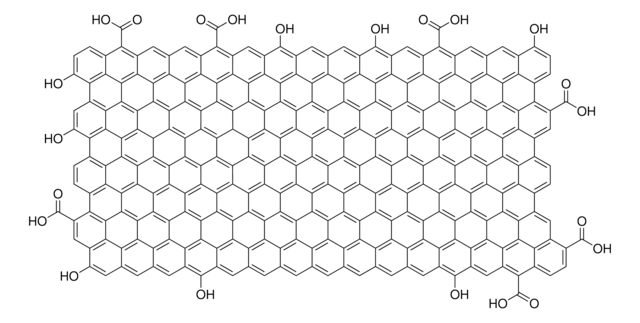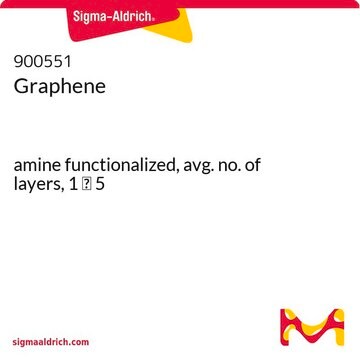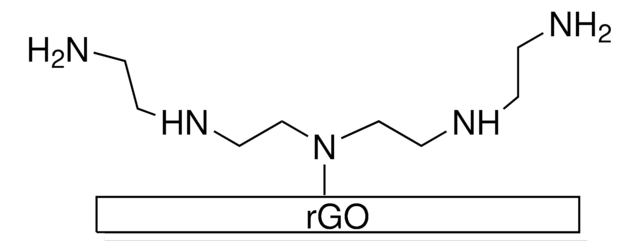Products may be shipped at a different temperature than the recommended long-term storage temperature. If the product quality is sensitive to short-term exposure to conditions other than the recommended long-term storage, it will be shipped on wet or dry-ice. If the product quality is NOT affected by short-term exposure to conditions other than the recommended long-term storage, it will be shipped at ambient temperature. As shipping routes are configured for minimum transit times, shipping at ambient temperature helps control shipping costs for our customers. For more information, please refer to the Storage and Transport Conditions document: https://www.sigmaaldrich.com/deepweb/assets/sigmaaldrich/marketing/global/documents/316/622/storage-transport-conditions-mk.pdf
900704
Graphene oxide
paste, non-exfoliated
Synonym(s):
Graphene oxide nanoplatelets
About This Item
Recommended Products
Quality Level
form
paste
composition
C, ≥3% (by gravimetric analysis combined with EA)
greener alternative product characteristics
Design for Energy Efficiency
Learn more about the Principles of Green Chemistry.
sustainability
Greener Alternative Product
greener alternative category
Related Categories
General description
Application
- Composites.
- Inks and coatings.
- Transparent conductive films.
- Supercapacitors.
- Batteries.
- Graphene oxide sheets at interfaces.
Signal Word
Warning
Hazard Statements
Precautionary Statements
Hazard Classifications
Eye Irrit. 2 - Met. Corr. 1 - Skin Irrit. 2
Storage Class Code
8B - Non-combustible corrosive hazardous materials
WGK
WGK 3
Flash Point(F)
Not applicable
Flash Point(C)
Not applicable
Choose from one of the most recent versions:
Already Own This Product?
Find documentation for the products that you have recently purchased in the Document Library.
Customers Also Viewed
-
How is shipping temperature determined? And how is it related to the product storage temperature?
1 answer-
Helpful?
-
-
How can I determine the shelf life / expiration / retest date of this product?
1 answer-
If this product has an expiration or retest date, it will be shown on the Certificate of Analysis (COA, CofA). If there is no retest or expiration date listed on the product's COA, we do not have suitable stability data to determine a shelf life. For these products, the only date on the COA will be the release date; a retest, expiration, or use-by-date will not be displayed.
For all products, we recommend handling per defined conditions as printed in our product literature and website product descriptions. We recommend that products should be routinely inspected by customers to ensure they perform as expected.
For products without retest or expiration dates, our standard warranty of 1 year from the date of shipment is applicable.
For more information, please refer to the Product Dating Information document: https://www.sigmaaldrich.com/deepweb/assets/sigmaaldrich/marketing/global/documents/449/386/product-dating-information-mk.pdfHelpful?
-
-
900704 Graphene OXide 25 g 900704-25G, regrading the above product, I am interested to know if it is useful for biological application?
1 answer-
This product is not tested for use in biological applications. However, graphene oxide is generally used in biological applications such as drug delivery, bioimaging, biosensing, and therapeutics.
Helpful?
-
-
I know you can not determine the molecular weight of graphene oxide, but is their an approximate or range of molecular weights I could calculate with?
1 answer-
Unfortunately, the molecular weight of this product is not determined.
Helpful?
-
-
Hello, I want to know more about the product, like whether it is graphene oxide (GO) or graphite oxide (GT), as the picture does not show the functional groups of the graphene oxide (GO). how to make the single layer graphene oxide from this powder.
1 answer-
900704 is a graphene oxide paste. Unfortunately, the functional group of the graphene oxide is not determined. To obtain a single layer of graphene oxide, dilute the aqueous paste with distilled or de-ionized water, preferably while stirring. Never dry the paste. Then use a sonication bath for about 0.5-1 hr. To obtain single sheets, the concentration should be below 0.04 wt%.
Helpful?
-
Active Filters
Our team of scientists has experience in all areas of research including Life Science, Material Science, Chemical Synthesis, Chromatography, Analytical and many others.
Contact Technical Service








